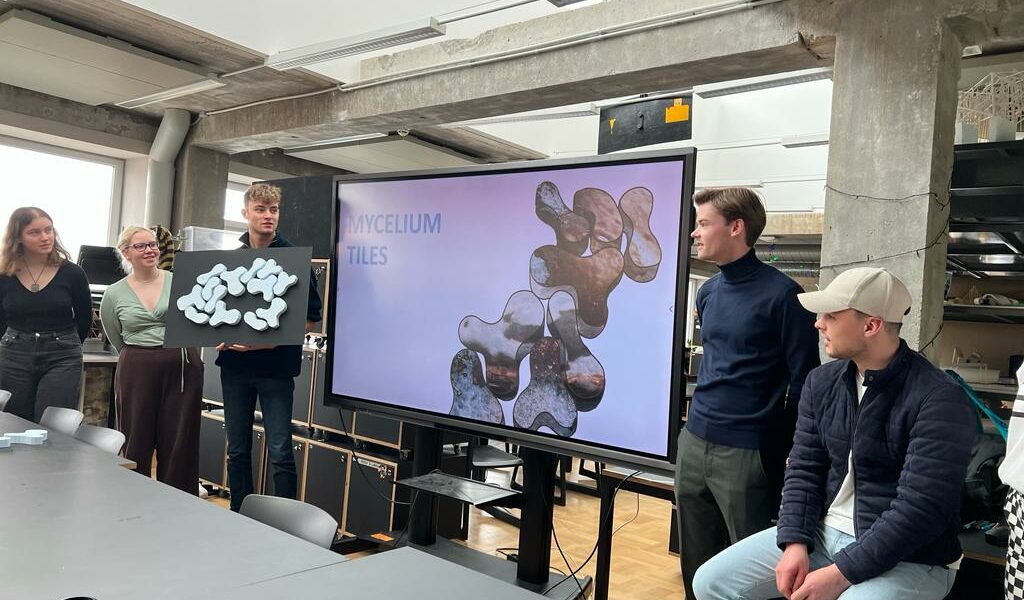
Presentation of Mycelium workshop at EKA
20–24 March an Erasmus+ intensive course was held in EKA in cooperation with the departments of interior architecture and textile design in which students from Estonia, Latvia, Lithuania, Finland, Hungary and Belgium tried to improve the spatial possibilities of the social program unit of the Tallinn Centre for Children at Risk and to expand the future prospects of the young people there. The group of forty students was divided into two: half focused on the emotional aspects of design in the screen printing workshop at EKA, and the rest focused on sustainable design, undergoing practical training in the laboratory of Myceen, a start-up that produces environmentally friendly materials from mushrooms. As a result of the joint workshop, conceptual solutions were prepared that offered spatial and sensory solutions for the social care institution located on Nõmme road. The workshop, which offered an international experience, broadened the world view of the students, showing them both their profession and their own career opportunities from the perspective of social design, where the designer’s contribution directly affects the course of society.
The format of Erasmus embedded intensive courses (BIP) is a short and intensive study program between higher education institutions of different countries, in which at least two higher education institutions from other European Union member states must participate in addition to the organizing higher education institution. The said course was held in cooperation with Ghent University (HoGent) from Flanders and Moholy-Nagy University of Art and Design (MOME) from Hungary. In addition to EKA’s textile and interior architecture students, students of interior design, product design, ceramics, as well as marketing and social pedagogy from partner universities contributed. In addition to EKA, HoGent and MOME students, students from Aalto University, the Latvian Academy of Arts and the Vilnius Academy of Arts also participated. As an innovation, the high school students of the Lasnamäe Russian High School were included among the participants in order to introduce future designers to the topics and methods with which creative people need to be taught.
Tallinna Laste Turvakeskus, which is a partner of the course, is a sub-institution of the city government, providing social welfare services for children and young people, as well as their parents. In addition to various safe home services, the center offers a social rehabilitation program for up to 40 children with behavioral and addiction disorders aged 10-17 at Nõmme tee 99. It is a controlled living and school environment where the child stays for a period of one academic year, during which the child’s addictive behavior and behavioral problems are dealt with. As part of the workshop, the students visited the premises of the institution located in Kristiine, talked with the employees there and learned from the experience of older colleagues working with similar institutions. Master of Interior Architecture Sandra Goroško, who has previously been a volunteer at the security center and now works with them as a designer, presented her thesis, which dealt with the improvement of the security center’s premises through the principles of co-design. Product designer and EKA PhD student Nesli Hazal Oktay introduced the student to how to use a mood board as an initial tool to tackle a complex problem.
In order to emphasize the importance of a creative approach and non-standard solutions, the students worked with materials and work methods that were previously unknown to many. Manifestos and t-shirts were made in the screen printing house under the supervision of Frank Abner, Erki Nagla and Siim Karro were the supervisors in the Myceen laboratory in the Naked Island creative and workshop center. In addition, Kärt Ojavee and Gregor Taul from EKA, Marleen Boonaert, Leen Poppe, Tomas Navratil, Vicky Verleyen and Tineke Wancour from HoGent, Janka Csernák from MOME and Fay Freeman from Falmouth University contributed as supervisors.
Kadi Kibbermann, Sandra Mell, Marilyn Riisimäe and Annamari Nael from EKA and Pirkko Runnel and Emeric Weber from Tallinn Children’s Safety Center contributed to the success of the course. Galleries of the workshop activities can be seen on the Facebook page of the Department of Interior Architecture.
